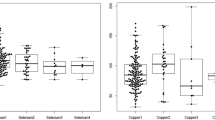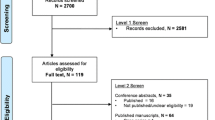Abstract
We aimed to explore the association of blood Zn, Fe, and Cu concentrations and changes in the pediatric risk of mortality (PRISM) score in critically ill children, to predict prognosis. We included 31 children (22 boys and 9 girls, 1 month to 5 years old), who had been admitted to the intensive care unit of our hospital and who were critically ill according to PRISM score of III. Another 20 children (12 boys, 8 girls, 3 months to 5 years old) who were brought to the hospital for a health checkup were included as controls. We recorded clinical data, time in the intensive care unit, prognosis, and PRISM III score for critically ill children. Blood Cu, Zn, and Fe values were measured by inductively coupled plasma atomic emission spectrophotometry. Zn and Fe levels were significantly lower in patients than in controls (all p < 0.05). Cu levels differed between patients and controls, but not significantly (p > 0.05). In ill children, blood Zn and Fe concentrations were inversely correlated with PRISM III score (Zn: r = −0.36; Fe: r = −0.50, both p < 0.05), with no significant correlation of blood Cu level and PRISM III score (r = −0.13, p > 0.05). Serious illness in children may lead to decreased Zn and Fe blood concentrations. Zn and Fe supplements may be beneficial for critically ill children.
Similar content being viewed by others
References
Engelgau M, Rosenhouse S, El-Saharty S et al (2011) The economic effect of noncommunicable diseases on households and nations: a review of existing evidence. J Health Commun 16:75–81, Review
Costa GA, Delgado AF, Ferraro A et al (2010) Application of the pediatric risk of mortality (PRISM) score and determination of mortality risk factors in a tertiary pediatric intensive care unit. Clin (Sao Paulo) 65:1087–1092
Volakli EA, Sdougka M, Drossou-Agakidou V et al (2012) Short-term and long-term mortality following pediatric intensive care. Pediatr Int 54:248–255
Von Dessauer B, Bongain J, Molina V et al (2011) Oxidative stress as a novel target in pediatric sepsis management. J Crit Care 26:103, e1-7
Chunchao H, Junhua Y, Yingzi W et al (2006) Hypoglycemic activity of fermented mushroom of Coprinus comatus rich in vanadium. J Trace Elem Med Biol 20:191–196
Han C (2009) Comparison of anti-hyperglycemic effect of inorganic constituents and organic in traditional Chinese medicine, Jinqi compound recipe. Biol Trace Elem Res 131(1):55–61
Kalkan Ucar S, Coker M, Sözmen E et al (2010) An association among iron, copper, zinc, and selenium, and antioxidative status in dyslipidemic pediatric patients with glycogen storage disease types IA and III. J Trace Elem Med Biol 24:42–45
Wang BH, Yu XJ, Wang D et al (2007) Alterations of trace elements (Zn, Se, Cu, Fe) and related metalloenzymes in rabbit blood after severe trauma. J Trace Elem Med Biol 21:102–107
Saaka M, Oosthuizen J, Beatty S (2011) Effect of joint iron and zinc supplementation on malarial infection and anaemia. East Afr J Public Health 6:55–62
Wang G, Lai X, Yu X et al (2012) Altered levels of trace elements in acute lung injury after severe trauma. Biol Trace Elem Res 147:28–35
Guo CH, Liu PJ, Lin KP et al (2012) Nutritional supplement therapy improves oxidative stress, immune response, pulmonary function, and quality of life in allergic asthma patients: an open-label pilot study. Altern Med Rev 17:42–56
Lambert J, Agostoni C, Elmadfa I et al (2004) Dietary intake and nutritional status of children and adolescents in Europe. Br J Nutr 92:S147–S211
Eide DJ (2011) The oxidative stress of zinc deficiency. Metallomics 3:1124–1129
Heyland DK, Jones N, Cvijanovich NZ (2008) Zinc supplementation in critically ill patients: a key pharmaconutrient? JPEN J Parenter Enteral Nutr 32:509–519
Nowak JE, Harmon K, Caldwell CC et al (2012) Prophylactic zinc supplementation reduces bacterial load and improves survival in a murine model of sepsis. Pediatr Crit Care Med 13:e323–e329
Lopez V, Keen CL, Lanoue L et al (2008) Prenatal zinc deficiency: influence on heart morphology and distribution of key heart proteins in a rat model. Biol Trace Elem Res 122:238–255
Beck FW, Kaplan J, Fine N et al (1997) Decreased expression of CD73 (ecto-5'-nucleotidase) in the CD8+ subset is associated with zinc deficiency in human patients. J Lab Clin Med 130:147–156
Opoka W, Adamek D, Plonka M et al (2010) Importance of luminal and mucosal zinc in the mechanism of experimental gastric ulcer healing. J Physiol Pharmacol 61:581–591
Ilhan A, Ozerol E, Güleç M et al (2004) The comparison of nail and serum trace elements in patients with epilepsy and healthy subjects. Prog Neuropsychopharmacol Biol Psychiatry 28:99–104
Artym J et al (2008) The role of lactoferrin in the iron metabolism. Part I. Effect of lactofferin on intake, transport and iron storage. Postepy Hig Med Dosw (Online) 62:599–612
Weiss G et al (2005) Modification of iron regulation by the inflammatory response. Best Pract Res Clin Haematol 18:183–201
Parkkinen J, von Bonsdorff L, Peltonen S et al (2010) Catalytically active iron and bacterial growth in serum of haemodialysis patients after i.v. iron-saccharate administration. Nephrol Dial Transplant 5:1827–1834
Pimenov LT, Biriukova TA et al (2010) Iron metabolism in elderly patients with ulcer disease. Adv Gerontol 23:115–118
Stephanie S (2010) Trace elements. Curr Anaesth Crit Care 21:44–48
Linko R, Karlsson S, Pettilä V et al (2011) Study group serum zinc in critically ill adult patients with acute respiratory failure. Acta Anaesthesiol Scand 55:615–621
Acknowledgments
We appreciate the support from the National Natural Science Foundation Council of China (30772458 and 81072508).
Author information
Authors and Affiliations
Corresponding authors
Rights and permissions
About this article
Cite this article
Wang, G., Feng, X., Yu, X. et al. Prognostic Value of Blood Zinc, Iron, and Copper Levels in Critically Ill Children with Pediatric Risk of Mortality Score III. Biol Trace Elem Res 152, 300–304 (2013). https://doi.org/10.1007/s12011-013-9623-x
Received:
Accepted:
Published:
Issue Date:
DOI: https://doi.org/10.1007/s12011-013-9623-x




